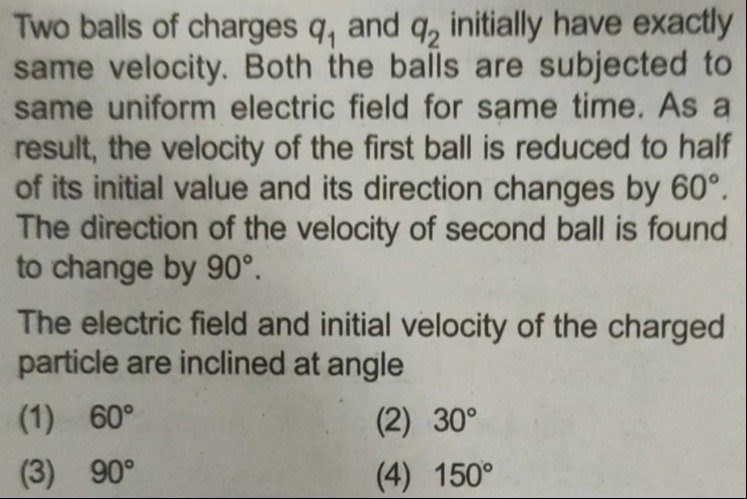Question
Question: Two balls of charges $q_1$ and $q_2$ initially have exactly same velocity. Both the balls are subjec...
Two balls of charges q1 and q2 initially have exactly same velocity. Both the balls are subjected to same uniform electric field for same time. As a result, the velocity of the first ball is reduced to half of its initial value and its direction changes by 60∘. The direction of the velocity of second ball is found to change by 90∘.
The electric field and initial velocity of the charged particle are inclined at angle

60∘
30∘
90∘
150∘
150^\circ
Solution
Let v0 be the initial velocity and E be the electric field. Let θ be the angle between v0 and E.
After time t, the velocities are v1=v0+A1 and v2=v0+A2, where A1=m1q1tE and A2=m2q2tE. A1 and A2 are parallel to E.
For the first ball, ∣v1∣=v0/2 and the angle between v0 and v1 is 60∘. From the vector triangle v0+A1=v1, using the law of cosines or dot product, the angle α1 between v0 and A1 is found to be 150∘ (required for speed reduction).
For the second ball, the angle between v0 and v2 is 90∘. From v0+A2=v2, taking the dot product with v0, we get v0⋅v0+v0⋅A2=v0⋅v2=0. v02+v0A2′cosθ=0, so A2′cosθ=−v0.
Using the geometric approach with angles of vectors relative to v0: Let v0 be along 0∘. v1 is at ±60∘. v2 is at ±90∘. A1=v1−v0. If v1 is at 60∘, direction of A1 is 150∘. A2=v2−v0. If v2 is at 90∘, direction of A2 is 150∘.
Since A1∥A2∥E, the direction of E must be in the set {150∘,210∘}. The angle θ between v0 (at 0∘) and E is the angle of E (in [0∘,180∘]). Thus, θ=150∘.
